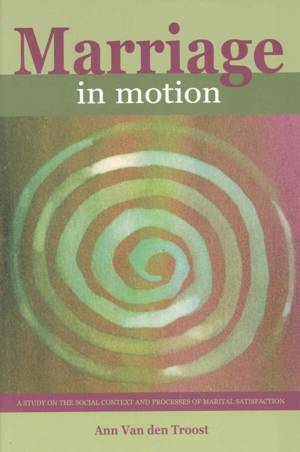
- Afhalen na 1 uur in een winkel met voorraad
- Gratis thuislevering in België vanaf € 30
- Ruim aanbod met 7 miljoen producten
- Afhalen na 1 uur in een winkel met voorraad
- Gratis thuislevering in België vanaf € 30
- Ruim aanbod met 7 miljoen producten
Zoeken
Marriage in Motion
A Study on the Social Context and Processes of Marital Satisfaction
A Vanden Troost
€ 33,00
+ 66 punten
Omschrijving
About 40 years after the onset of the so-called second demographic transition, Marriage in Motion examines the underlying processes and correlates of spouses' satisfaction with marriage. Among other things, this transition has been characterized by an upward trend of divorces turning marriage into a vulnerable institution. It is, therefore, of utmost importance to gain insight in the features of longer-term marriages. The present study is directed towards the generation that instigated the quantitative and qualitative changes in the private sphere. Using longitudinal data of a representative sample of married husbands and wives in the Netherlands, Marriage in Motion tackles several issues that are relevant to contemporary marital life. How do economic and cultural factors affect spousal marital satisfaction? What role does communication play in understanding husbands and wives' satisfaction with marriage? How do parenting experiences spill over to the spousal system? What are the implications of masculine and feminine self-definitions on partners' evaluation of marriage? The elaboration of these and other related questions offer the reader a broad picture of the role of gender, communication, parenting and individuals' socioeconomic position in understanding spousal marital experiences.
Specificaties
Betrokkenen
- Auteur(s):
- Uitgeverij:
Inhoud
- Aantal bladzijden:
- 302
- Taal:
- Engels
- Reeks:
Eigenschappen
- Productcode (EAN):
- 9789058674647
- Verschijningsdatum:
- 15/02/2005
- Uitvoering:
- Paperback
- Formaat:
- Trade paperback (VS)
- Afmetingen:
- 156 mm x 234 mm
- Gewicht:
- 453 g

Alleen bij Standaard Boekhandel
+ 66 punten op je klantenkaart van Standaard Boekhandel
Beoordelingen
We publiceren alleen reviews die voldoen aan de voorwaarden voor reviews. Bekijk onze voorwaarden voor reviews.








